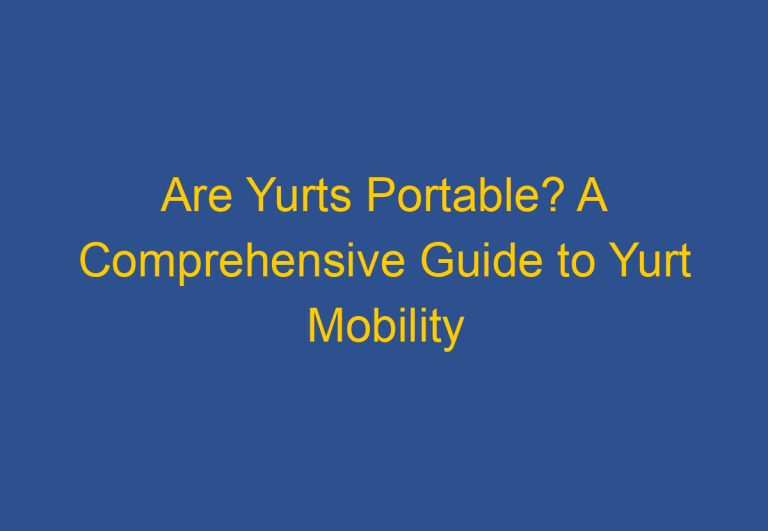Are Yurts Legal in California? A Comprehensive Guide to Yurt Regulations in the State
Yurts have become a popular choice for those seeking a unique and eco-friendly living experience in California. However, the legality of living in a yurt in California is a question that many people ask. While yurts are not explicitly banned in California, there are certain regulations that must be followed to ensure that they are legal.
In California, yurts are considered temporary structures and are often used for camping or glamping. As such, they are subject to different regulations than permanent structures. These regulations vary depending on the county and city in which the yurt is located. It is important to research the codes of the county in which you want to build a yurt and ensure that your yurt meets local zoning and building codes.
While yurts are often associated with a rustic and natural lifestyle, they are not exempt from California’s building codes and regulations. Yurts must meet certain safety standards to be considered legal, including requirements for fire resistance, ventilation, and structural integrity. It is also important to note that yurts are typically made of wood and canvas, which can be vulnerable to the elements and require regular maintenance to remain in good condition.
Legal Aspects of Yurt Construction in California
When it comes to building a yurt in California, there are several legal aspects that one needs to consider. This section will cover the building codes and permits, zoning regulations and restrictions, as well as safety and compliance standards.
Building Codes and Permits
Building codes and permits are essential when it comes to constructing a yurt in California. If the yurt is being used for residential purposes, it must meet local regulations for residences, including heat source, size and type of openings, egress windows in sleeping areas, and so on. If the yurt is being used for commercial purposes, it must also meet an additional set of commercial regulations.
The International Code Council (ICC) codes are the most commonly used building codes in California. These codes provide guidelines for construction, plumbing, electrical, and mechanical systems. The codes also provide guidelines for fire-rating requirements, snow load, seismic rating, wind speed, and other safety standards.
Zoning Regulations and Restrictions
Zoning laws and local planning regulations vary from county to county in California. In some counties, such as Napa and Mendocino, yurts are permitted for a range of uses, including housing. In other counties, such as Marin, yurts are only permitted as non-habitable structures.
It is important to check with the local building department to determine the zoning laws and local planning regulations in the area where the yurt will be constructed. This will help ensure that the yurt is in compliance with all local zoning laws and regulations.
Safety and Compliance Standards
Safety and compliance standards are essential when it comes to building a yurt in California. The yurt must meet all safety standards and comply with all building codes and regulations. This includes ensuring that the yurt is constructed with the appropriate materials and that it is properly anchored to the ground.
In addition, if the yurt will have a wood stove, it must meet all safety standards and comply with all building codes and regulations. The local building officials can provide guidance on the appropriate wood stove to use in the yurt.
In conclusion, building a yurt in California requires careful consideration of the building codes and permits, zoning regulations and restrictions, as well as safety and compliance standards. It is important to work closely with the local building department and building officials to ensure that the yurt is in compliance with all local regulations and standards.
Living in a Yurt in California
Yurts are becoming increasingly popular in California as a unique and affordable housing option. They are available in various sizes and styles, and they provide a tranquil and peaceful living experience. In this section, we will discuss the lifestyle and amenities of living in a yurt, maintenance and upkeep, and yurt communities and locations in California.
Lifestyle and Amenities
Living in a yurt in California is a unique experience that offers residents a chance to live close to nature. Yurts are typically located in serene and secluded areas, which offer a peaceful and relaxing environment. They are perfect for those who love outdoor activities such as hiking, camping, and nature walks. Yurts are also a great option for those who want to experience glamping, which is a luxurious form of camping.
Yurts are designed to be comfortable and provide all the necessary amenities for a comfortable living experience. They come equipped with bedding, furniture, and heating systems to keep residents warm during the winter months. Yurts also have ample space for storage and provide a cozy living space.
Maintenance and Upkeep
Maintenance and upkeep of a yurt are relatively easy compared to traditional houses. The canvas and wood used in yurt manufacture are durable and can withstand harsh weather conditions. Insulation materials are used to keep the yurt warm during the winter months. The platform and wooden frame of the yurt are designed to be sturdy and long-lasting.
However, it is important to note that yurts are considered temporary structures in California, and they require regular maintenance to keep them in top condition. Regular cleaning and maintenance of the canvas, wood, and insulation materials are essential to ensure the longevity of the yurt.
Yurt Communities and Locations
Yurt communities in California are becoming increasingly popular, and they provide a unique living experience. Many yurt communities are located in serene and secluded areas, which offer a peaceful and relaxing environment. Yurt communities are also a great option for those who want to experience communal living and enjoy the company of like-minded individuals.
Yurts are located in various locations in California, including campgrounds, Joshua Tree National Park, beaches, and the Redwoods. They are also located in the Sierra Nevada, which offers residents access to hiking trails and outdoor activities.
Overall, living in a yurt in California is a unique and affordable housing option that provides a tranquil and peaceful living experience. Yurts are perfect for those who love outdoor activities, glamping, and nature walks. They are also relatively easy to maintain and come equipped with all the necessary amenities for a comfortable living experience.
Frequently Asked Questions
What are the zoning requirements for erecting a yurt in California?
The zoning requirements for erecting a yurt in California depend on the county and the local building officials. In general, yurts are considered temporary structures and may be prohibited in certain areas. It is important to research the zoning requirements in your specific location before erecting a yurt.
Can yurts be used as permanent residences in California?
Yurts can be used as permanent residences in California, but it depends on the county and the local building officials. Some counties may require that yurts be used only as temporary structures, while others may allow them to be used as permanent residences. It is important to research the specific regulations in your county before using a yurt as a permanent residence.
What building codes apply to yurts in California?
Yurts in California are subject to the same building codes as other structures. The California Building Standards Code requires that yurts meet certain structural and safety requirements, such as fire resistance, ventilation, and electrical wiring. It is important to ensure that your yurt meets all applicable building codes before erecting it.
How does California classify yurts for property tax purposes?
In California, yurts are classified as personal property rather than real property for property tax purposes. This means that they are subject to personal property taxes rather than real property taxes. However, if a yurt is permanently affixed to a foundation, it may be considered real property and subject to real property taxes.
Are there any specific regions in California where yurt living is more regulated?
Yurt living in California may be more regulated in certain regions, such as coastal areas and mountain regions. These areas may have stricter building codes and zoning regulations due to concerns about environmental impact and fire safety. It is important to research the specific regulations in your region before erecting a yurt.
What permits are needed to install a yurt on private property in California?
Permits may be required to install a yurt on private property in California, depending on the county and the local building officials. In general, permits are required for any new construction or structural modifications. It is important to research the specific permit requirements in your county before erecting a yurt.












